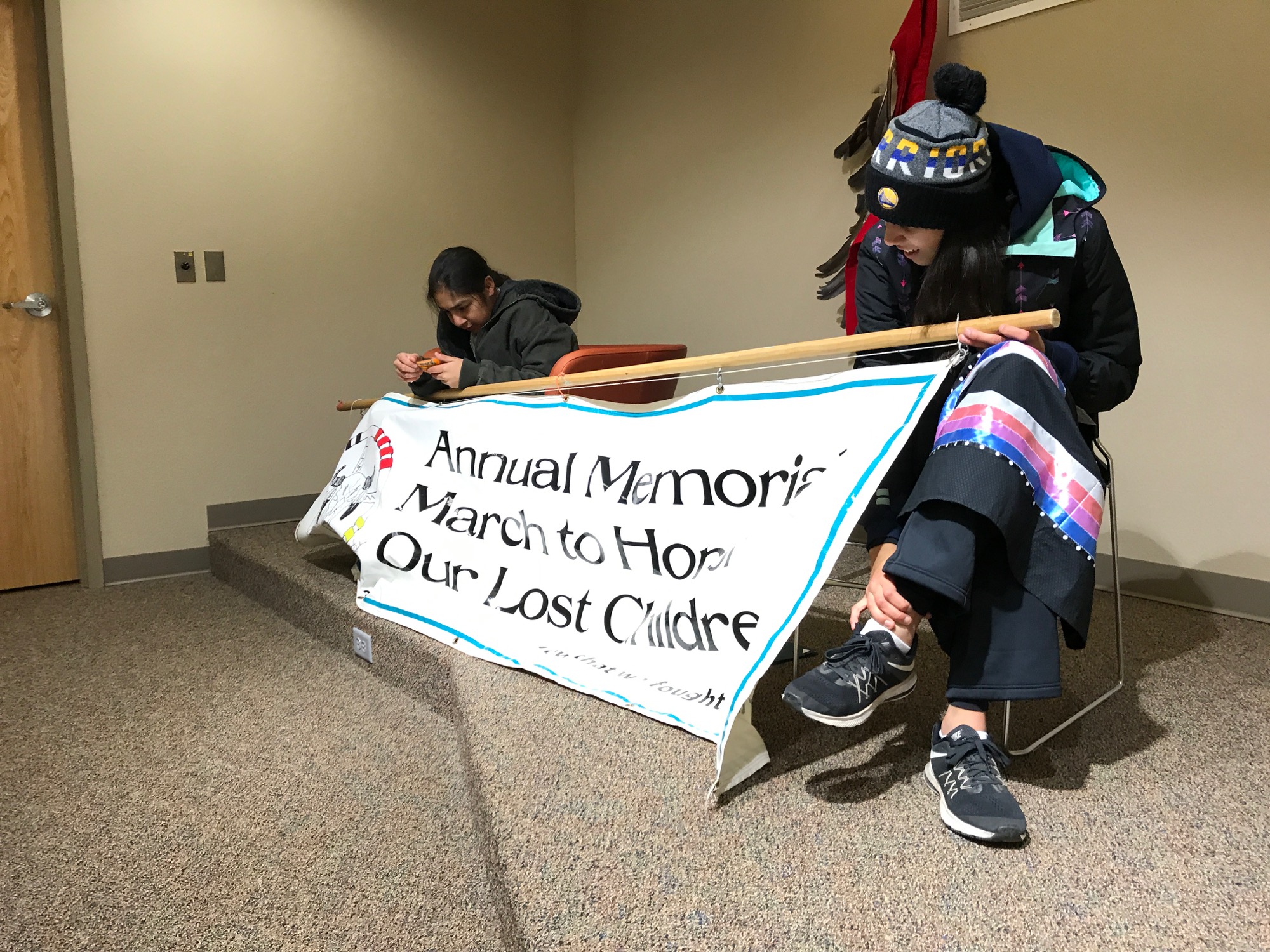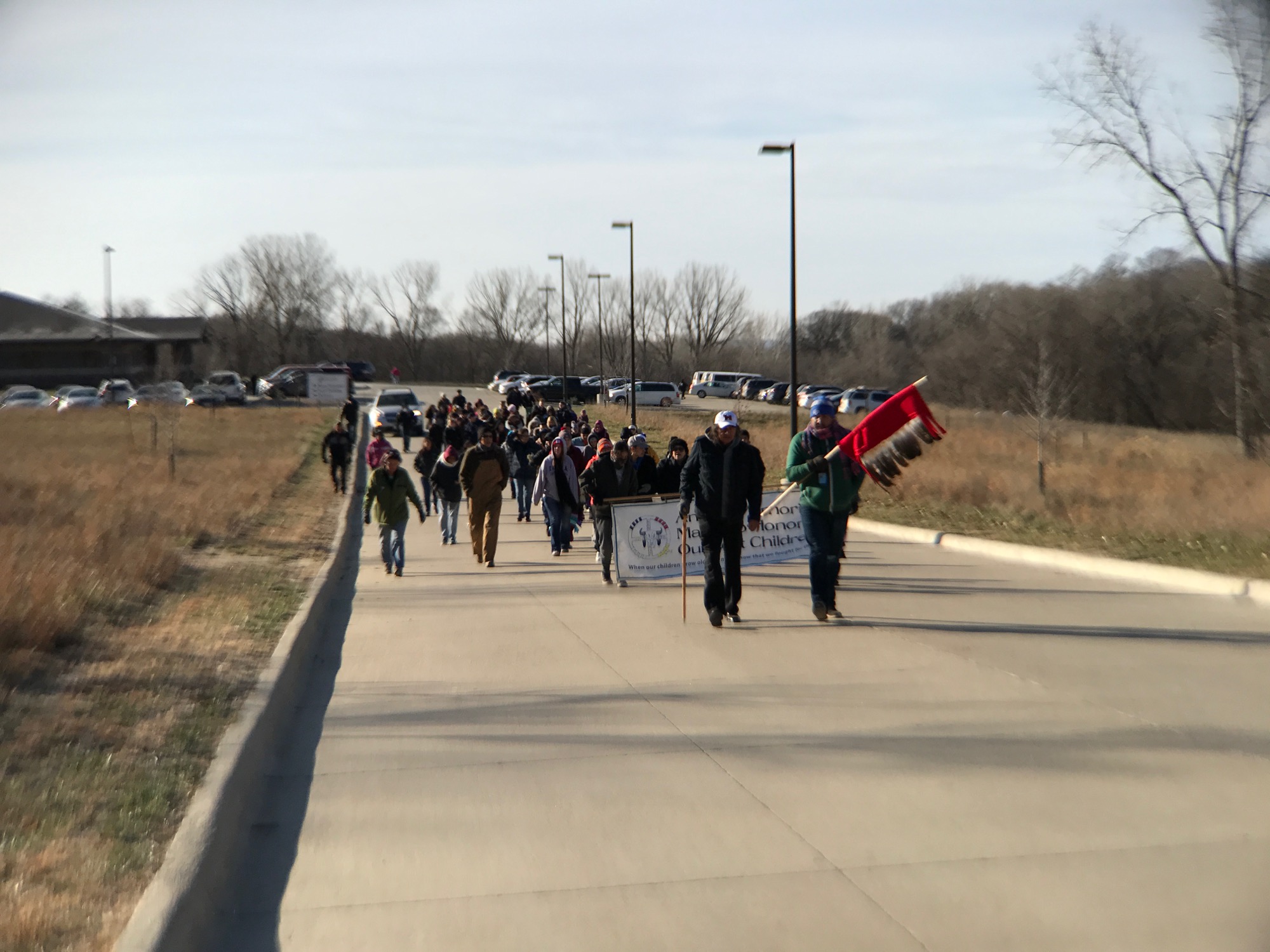'We love you and we need you and we want you in our lives'
15th annual Memorial March to Honor Our Lost Children in Iowa
By Kevin Abourezk
@Kevin_Abourezk $ti
SIOUX CITY, Iowa — Fifteen years ago, Native people in Sioux City sought the help of Iowa state leaders.
Too many of their children were being removed from their homes, they told state officials.
Too many were failing to return, they said.
Too many were being abused and murdered in state foster homes, they said.
But deaf ears turned their pleas into anger, and they sought a way to express that frustration.
Daniel Bearshield was there, a 34-year-old Santee Sioux man seeking answers to why so many Native children were being lost to the state child welfare system.
“We were dealing with a lot of hostility, a lot of prejudice, a lot of racism,” he said.
Native American parents and advocates decided to march.
They walked to the Woodbury County Courthouse and to the state Department of Human Services, places where strangers had too long decided the fate of their children. They marched with fists held high and chanted.
“What do you do when your rights are under attack?” they shouted. “Stand up, fight back!”
And they’ve continued to march, every year since.
Native youth hold a banner for the 15th annual Memorial March To Honor Our Lost Children in Sioux City, Iowa.
Marchers gather at the base of the War Eagle Monument in Sioux City, Iowa.
Marchers gather at the base of the War Eagle Monument in Sioux City, Iowa.
Marchers gather in War Eagle Park in Sioux City, Iowa.
Michael Murphy, an Omaha folk musician, performs a song using a Native flute at the War Eagle Monument in Sioux City, Iowa.
Frank LaMere, a Winnebago activist, at the base of the War Eagle Monument in Sioux City, Iowa.
Marchers in Sioux City, Iowa.
Marchers in Sioux City, Iowa.
Marchers approach the intersection of Hamilton Boulevard and West Fourth Street in Sioux City, Iowa.
Marchers approach the intersection of Hamilton Boulevard and West Fourth Street in Sioux City, Iowa.
Marchers walk past the intersection of Hamilton Boulevard and West Fourth Street in Sioux City, Iowa.
Marchers walk past the intersection of Hamilton Boulevard and West Fourth Street in Sioux City, Iowa.
Frank LaMere, a Winnebago activist, speaks inside the Siouxland Center for Active Generations in Sioux City, Iowa.
Marchers leave the Siouxland Center for Active Generations in Sioux City, Iowa.
Marchers walk toward the Woodbury County Courthouse in Sioux City, Iowa.
Marchers walk toward the Woodbury County Courthouse in Sioux City, Iowa.
Marchers enter the Woodbury County Courthouse in Sioux City, Iowa.
A drum group sings inside the Woodbury County Courthouse in Sioux City, Iowa.
Frank LaMere, a Winnebago activist, speaks inside the Woodbury County Courthouse in Sioux City, Iowa.
Marchers congregate inside the Woodbury County Courthouse in Sioux City, Iowa.
Previous
Next
All photos by Kevin Abourezk
This year, nearly 160 people joined in a brisk, three-mile walk from War Eagle Park in Sioux City to the Woodbury County Courthouse as part of the 15th Annual Memorial March to Honor Our Lost Children.
As he has every year, Winnebago activist Frank LaMere led the way.
Standing before the 31-foot statue of Santee Sioux Chief War Eagle on a hill overlooking the Missouri River, LaMere invoked the names of three children murdered in foster homes, deaths that inspired the first march so many years ago.
Hannah Thomas, Nathaniel Saunsoci-Mitchell and Larissa Starr-Red Owl.
“There are others since then and others before them,” LaMere. said. “They are Native children.They are non-Native children.
“What we do when we come here is we elevate the discussion about the need for us to do what we can to keep families intact and to reunite them when we can and to give all of those children an opportunity to live, to grow and to flourish.”
In addition to the march this year, Sioux City law enforcement officials and Native American leaders participated in a town hall meeting Monday, and a local college — Briar Cliff University — hosted a two-day workshop that ended Tuesday.
The march itself began at War Eagle Park and continued east to Jackson Recovery Centers, a treatment center, where marchers stopped for coffee and speeches.
LaMere thanked the state of Nebraska for closing the four beer stores in Whiteclay, a decision capped in September by a Nebraska Supreme Court decision rejecting the liquor licenses for those four stores.
LaMere said it is now up to Native people to do their part to ensure the well-being of their children.
“It took a long time but they did what we asked them to do,” he said. “We we have to get well. We’ve got to ask tough questions of ourselves.”
The marchers then proceeded to the Siouxland Center for Active Generations, where they stopped again for coffee and presentations.
Kellie Snow, a Winnebago Tribal Council member, called on men and boys in the audience to get sober and come home to their people.
“We love you and we need you and we want you in our lives,” she said. “We want you to lead us.”
Jerry Foxhoven, director of the Iowa Department of Human Services, said state leaders are working hard to reunite children with their families and working to help parents get healthy.
“I’m going to be at this march every year,” he said. “Because I think it’s a symbol. It’s a symbol that we’re in this together. Together, I know we can be successful.”
LaMere said the march has already helped reunite Native children and their families. He shared the story of an adoptive family who had once watched a television news story about the march and happened to see a Native woman who’d lost her parental rights carrying her baby’s picture. They instantly recognized the baby.
They contacted the birth mother and were able to reunite her with her child.
The march Tuesday ended at the Woodbury County Courthouse, where marchers gathered for Native American drumming and singing, as well as speeches by county officials and judges.
Bearshield talked about the march’s first year, when marchers tried to walk into the courthouse but were stopped by the sheriff. The marchers forced their way into the building.
“We weren’t welcome,” he said. “I think we shook this building.”
He lamented the loss of Native leaders like Judy Yellowbank, former program manager for the Four Directions Community Center in Sioux City, who died in October 2016. He called on Native youth to take up the mantle of leadership.
“We kept that wolf away from the door, but that wolf’s going to return,” he said.
Join the Conversation





















